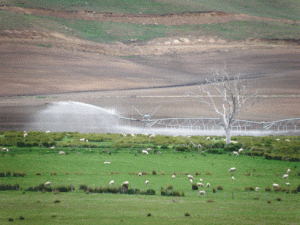IN this introductory article last week, we examined how stock numbers, rainfall and property listing numbers were likely to influence the success of grazing property sales in 2016.
This week we add two additional factors to that list – the level of property improvements, plus currency movements and interest rates.
 CBRE regional director of agribusiness, Danny Thomas suggests that properties that have become run-down over the past couple of years will be harder to shift than those where infrastructure like fencing, water and woody weed control have been well maintained.
CBRE regional director of agribusiness, Danny Thomas suggests that properties that have become run-down over the past couple of years will be harder to shift than those where infrastructure like fencing, water and woody weed control have been well maintained.
Mr Thomas said bad seasonal conditions and poor prices were to blame for any run-down in recent property maintenance. Unfortunately, he said, people who fail to update or continue repairs and maintenance on their properties will pay the price when it comes to sell.
“A property where country, fences, laneways, stock-working facilities and workers accommodation have been well-maintained will always be more attractive than one that needs $1m or $2m getting things ‘ship shape’ again,” he said.
“Properties that are operating and generating good cash flow and don’t need a lot of capitals work, such as cattle, physical repairs, maintenance or construction of new improvements, will always be preferred.”
Interest rates, currency movements will have a bearing
Interest rates and the level of the Australian dollar are other important factors when it comes to prospects for property listings and sales outcomes this year. According to Westpac chief economist Bill Evans, interest rates are likely to stay flat and hold that way this year, with the first likely move in the second half of 2017. NAB’s predictions are much the same – remaining stable in 2016.
What about the exchange rate? A low A$ value relative to the US$ not only enhances the attractiveness of Australian beef exports on the international stage, but makes offshore investment in Australian land assets look relatively cheaper.
Mr Evans believes the A$ will remain relatively flat and at current levels. NAB, allowing for a 20 percent fluctuation, expects the currency to drop to US66c and at its peak reach just over US70c.
Steve Hannan, Westpac National Agribusiness Manager, said this meant interest from overseas buyers for Australian cattle properties is likely to remain strong. “Investors have a long term view and their interest is in quality produce,” he said.
Mr Hannan said once widespread rain falls, he expects to see more interest in selling and purchasing properties by locals, particularly in the drier areas.
The volume of farm management deposits is quite healthy at the moment, according to Mr Hannan.
“Farmers have been quite conservative over the past three to four years, especially in Queensland, northern NSW and the western part of Victoria where it’s been quite dry. They have been happy building up their reserves and putting equity back into their business balance sheets until things improve and opportunities present themselves.”
Mr Hannan explained that many customers had plans in place and when they feel confident, they’d be ready to do business. “For many it depends on rain. Most farmers are looking to build scale and are on the lookout for the right property when it presents itself.”
NAB’s head of agribusiness, Khan Horne, agrees, saying the level of FMDs had been ‘absolutely astronomical’, and he backed the claims with industry data.
“In November 2015, farm management deposits across all states totalled almost $4b, an increase of $44m over the previous year. More specifically, in the beef industry, FMDs in 2014 rose $69m to $464m in 2015,” he said.
Mr Horne said Farm Management Deposits were a good illustration of profitability because farmers did not have FMDs unless there was a surplus cash flow.
Townsville-based livestock and rural property agent Tim McHugh is reluctant to predict what the future holds for the cattle property market over the next three to six months.
“The picture will be clearer at the end of March, but right now I am extremely positive – rain or no rain. The cattle market’s going to stay strong and at the end of the day it’s going to come down to supply and demand.”
“I’m hearing that Indonesian feedlots are only at 40 percent capacity, so demand will continue even in the face of a decent wet season.”
Mr McHugh is confident the rural property market in his region will be very positive this year. “I think there’s going to be solid demand – definitely properties with cattle are going to achieve a premium price. Bare properties will be determined on quality, location and improvements.”
Mr Hannan said with the interest rate position being low, coupled with strong cattle prices, buyers and sellers of Australian cattle properties were quietly optimistic, albeit cautious.
Mr Horne said he wasn’t a valuer, however he had observed a significant increase in NAB’s leasing volumes. “People are leasing more, which means times are good,” he said.
Movement at the Station
- More than one million hectares of Kimberley grazing country, comprising Moola Bulla, Mt Amhurst, Beefwood Park and Shamrock stations, are being offered by SAWA Pastoral Co principals, the Botha Family.
- Well known Northern Territory breeding and growing property, Numery Station is up for sale. Situated 180km east of Alice Springs, it covers more 202,200ha.
- And in north Queensland, Esmeralda Station covering a massive 399,000ha is under contract. It comes with 30,000 head of high grade Brahman cattle.
For more details on these and other recent listings, click here, or to view the latest property sale results, click here.


HAVE YOUR SAY